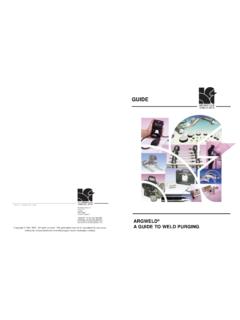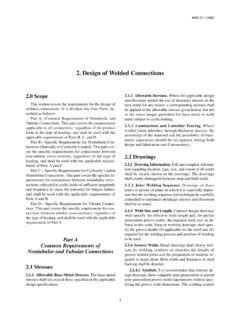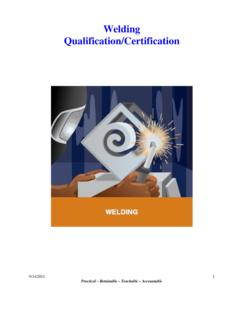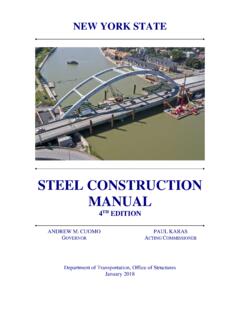Transcription of Welder™s Handbook
1 Welder s Handbook For Gas Shielded Arc Welding, Oxy Fuel Cutting & Plasma Cutting Published by: Air Products PLC. Designed and produced by: PDF Conceptual Design & Marketing Copyright: Air Products PLC 1999 3rd Edition Air Products Welder s Handbook CONTENTS. Introduction Fusion welding 2. Why use welding? 3. Arc welding processes 4. Welding terms 5. MIG/MAG welding 6. TIG welding 10. Plasma welding 17. Welding sheet 18. Welding plate 20. Welding pipes 22. Defects in welds 24. The right gas: MIG/MAG welding 26. TIG welding 29. Welding data: MIG/MAG welding 30.
2 Flux cored electrodes 33. TIG welding 34. Oxy-fuel gas cutting 37. Plasma cutting 44. Safety always 46. Conversion data inside back cover 1. Air Products Welder s Handbook Fusion welding 'T' joint The most widely used welding proc- esses rely on fusion of the components fillet at the joint line. weld In fusion welding, a heat source melts the metal to form a bridge between the components. Two widely used heat sources are: electrode high current low voltage Butt joint butt supply weld arc Electric arc fuel gas flame blowpipe air must be excluded from heated area Gas flame The molten metal must be protected from the atmosphere - absorption of oxygen and nitrogen leads to a poor quality weld .
3 Air in the weld area can be replaced by a gas which does not contaminate the metal, or the weld can be covered with a flux. 2. INTRODUCTION. Why use welding? Which process? Welding is used because it is: A large number of welding processes and techniques are available. No one of the most cost-effective process is universally best. Each has methods of joining metal its own special attributes and must be components matched to the application. suitable for thicknesses ranging Choosing the most suitable process from fractions of a millimetre to a requires consideration of a number of third of a metre factors.
4 Versatile, being applicable to a wide range of component shapes and sizes The joints produced by welding are: Factors in choosing permanent welding process: strong, usually matching the strength of the components, type of metal leak tight, type of joint reproducible, production constraints readily inspected by non- equipment availability destructive techniques. labour availability Welding can be used: health, safety and the environment in the workshop costs of consumables on site labour costs for material thickness sheet plate pipe sections 3.
5 Air Products Welder s Handbook ARC WELDING. Arc welding processes Two of the most important processes use a gas shield to protect the weld metal from atmospheric Fabrications involving sheet metal, contamination. plate or pipes are commonly welded by an arc process. 4. WELDING TERMS. Terms commonly used in filler metal Metal added to the weld pool during welding. For TIG it is gas shielded welding supplied as cut lengths of wire. interpass temperature The arc length Distance between the tip temperature of the material adjacent to of the electrode and the surface of the the joint between each run is the weld pool.
6 Interpass temperature. In some base metal Incorrectly used to applications, a maximum temperature describe the metal from which the is specified to avoid metallurgical components of the joint are made. changes in the metal. The correct term is parent metal. melt run Melting the parent metal bead A single run of weld metal by passing a TIG arc along the deposited onto the surface of the surface. Filler metal is not used. parent metal. nozzle In TIG and MIG/MAG. burn-off rate The rate at which the welding - A metal or ceramic tube wire is melted.
7 Quoted as a linear which confines the shielding gas to measurement - m/min (metres per the weld area. minute) or in/min. parent metal The metal which is to deposited metal Material which is be joined by welding. Often incorrectly added, either from the electrode or called the base metal. filler wire, to build up the weld profile. pass or run The metal deposited during one traverse of the joint by an deposition rate The rate at which arc. In TIG welding without a filler, the melted electrode metal is added to the term melt run may be more correct.
8 weld pool. Quoted in kg/hr (kilograms per hour). Sometimes incorrectly preheat temperature The temperature of the parent metal just used in reference to the ratio of metal before welding is started. With some deposited to the amount of electrode metals the parent metal is heated melted - this is the deposition before efficiency. welding to avoid problems such as cracking or lack of fusion. electrode The flux coated rod in manual metal arc welding, the root run The first run deposited in a tungsten in TIG and plasma welding joint where further runs are needed to and the consumable wire in MIG/MAG fill the groove.
9 Welding. The arc is formed between sealing run A run of weld metal the parent metal and one end of the deposited on the reverse side of a butt electrode. joint, along the line of the root. 5. Air Products Welder s Handbook MIG/MAG welding principles The shielding gas can be: pure argon Gas shielded metal arc welding is a argon mixed with small semi-automatic process which is amounts of other gases suitable for both manual and mechanised operation. helium or carbon dioxide It is known by a variety of names: according to the metal being welded.
10 MIG - Metal Inert Gas MAG - Metal Active Gas See pages 9 and 26. CO2 - carbon dioxide A low voltage (18 40V), high current (60 500A) arc between the end of a wire electrode and the work provides the heat needed for the welding nozzle to plate distance-kept at operation. The arc and the weld are about 19-25mm protected from atmospheric contamination by a gas shield. drive rolls keep constant wire feed speed arc length spool of wire power supply unit keeps arc work length constant gas nozzle shielding gas 6. MIG/MAG WELDING. Operation overhead An electric motor feeds the wire into the arc and the power source keeps the arc length at a preset value leaving the welder to concentrate on ensuring complete fusion of the joint.








